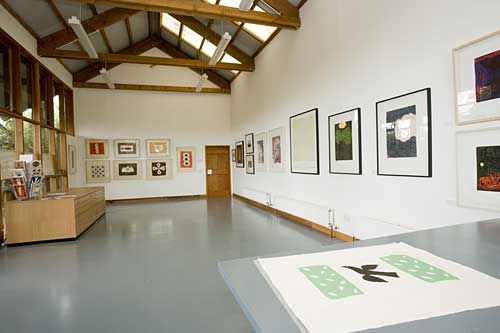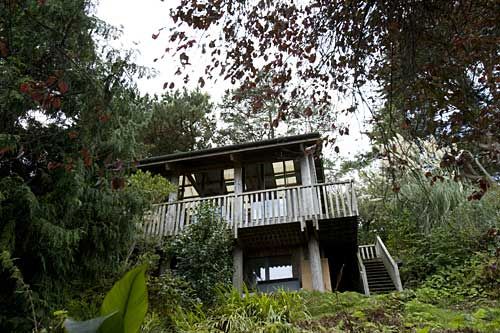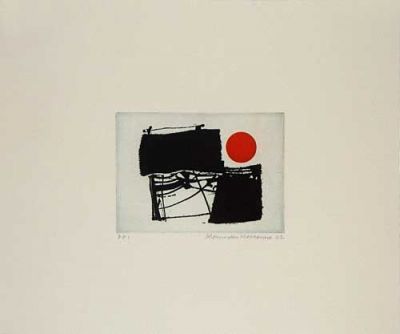|
|
| home | features | exhibitions | interviews | profiles | webprojects | gazetteer | links | archive | forum |
|
Hugh Stoneman Peta-Jane Field
Hugh Stoneman’s hand made prints, created in collaboration with artists and now displayed in his old studio space, reveal his passion for the image. A peerless master printmaker, the late Hugh Stoneman worked closely with internationally renowned artists including many of Cornwall’s best loved practitioners, Breon O’Casey, the late Sandra Blow, Sir Terry Frost and Patrick Heron, always seeking alternative methods of creating new images for them. Hugh also produced limited fine art print editions for major museums including the Tate Gallery, the Metropolitan Museum in New York and the Scottish National Gallery.
Fine art printmaking is a hidden art form, shrouded by confusing terms, frequently regarded as playing second fiddle to painting. Yet every individual print is created meticulously, and Hugh’s methods offered an artist a wealth of different forms of expression. Winter Field, an etching by Alexander Mackenzie (below bottom), its deep red circle and black angular forms strikingly set against a white background, is counterpoint to the vivid colour of John Hoyland’s Flying Wild. The contrasting styles of these two prints alone highlight Hugh’s great skill.
Even though some printmaking methods are over two hundred years’ old,
contemporary
printmaking is a melding of science and the art of painting, intuitive
creative ideas tempered with down-to-earth practicality. “Hugh’s
fingers were always ink-stained,” says Linda. “I particularly want
visitors to remember this space was once his studio. So I have left his
faint inky finger prints which he unwittingly daubed on the door frames
and Of course Hugh was more than a printmaker to all the artists with whom he worked. “Hugh always made them feel special, as if they were the only one he was thinking about at the time,” explains Linda. “Before any artist arrived, Hugh would clear away all his other work so his studio was ready for the new printmaking project.” Linda’s gallery reflects his warmth - no wonder it was crammed full of people wishing to pay tribute to Hugh for the opening of his current exhibition at Tate St Ives.
Stoneman Graphics Gallery, Orchard Flower Farm, Madron Hill is open on Thurs and Fri 10am- 5pm, and on Sat morning 10am - 1pm. A special display of Hugh Stoneman’s work is being shown until Sat 10 May. Visitors are welcome to drop in within these hours or contact the gallery for a private appointment on 01736 361756 or 01736 351363 or visit www.stonemanpublications.co.uk words: Peta-Jane Field, images: Linda Stoneman. Article appears courtesy 'Inside Cornwall'
|
|
|


 After
studying painting at Camberwell Art College in the late sixties, Hugh
was initiated into the art of printmaking by William Hayter in his
experimental workshop, Atelier 17, in Paris. Hugh quickly realised ‘the
potential of the print as a primary medium for artists.’ The scope of
his work is breathtaking. Sublimating etching, woodcut, linocut and
monograph techniques, Hugh resurrected the lost art of dust-grain
gravure and photogravure which ‘became a distinctive studio process,
capable of creating rich and subtle effects.’ One of Hugh’s greatest
strengths was the fearless way he experimented with different
techniques.
After
studying painting at Camberwell Art College in the late sixties, Hugh
was initiated into the art of printmaking by William Hayter in his
experimental workshop, Atelier 17, in Paris. Hugh quickly realised ‘the
potential of the print as a primary medium for artists.’ The scope of
his work is breathtaking. Sublimating etching, woodcut, linocut and
monograph techniques, Hugh resurrected the lost art of dust-grain
gravure and photogravure which ‘became a distinctive studio process,
capable of creating rich and subtle effects.’ One of Hugh’s greatest
strengths was the fearless way he experimented with different
techniques. light switches as he went about his daily work.” Needless to say, these
marks add a poignant touch to the Gallery, bringing to mind the essence
of a man who spent his lifetime dedicated to printmaking.
light switches as he went about his daily work.” Needless to say, these
marks add a poignant touch to the Gallery, bringing to mind the essence
of a man who spent his lifetime dedicated to printmaking.